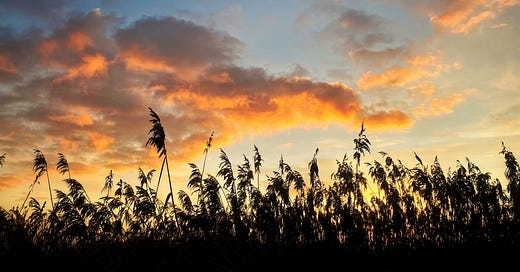Cordgrass stops coastal erosion. So it was seeded everywhere along the Morecambe bay. Now it’s here to stay.
It draws the sand into clumps, and between them form tidal pools. As a child, if we wanted to reach the sands, we would have to jump from tussock to tossock, for the fifty metres or so along the coast. These tussocks are great at breaking up waves, naturally forming protuberances the likes of which are so often emulated by concrete coastal protectors. This is why the grass was seeded here, and elsewhere along many shores around the world.
My Dad dislikes the grass. He says it comes from Japan, but I think maybe this variety comes from California. His narrative is that it was carried here on the ballast of ships, and is invasive. I doubt this is true, but it is virile indeed: one time I tried to cut seaweed, mix it with bracken to make compost, in line with my grandma’s recipe, to make a mulch which decomposes fast and hot. However, the compost heap suddenly grew tall and thick with cordgrass, whose seeds were mixed in with the coastal forage.
Maybe this proved my Dad’s point? But, as historical photos have shown me, the grass was in the bay since well before he came here.
So imagined, perhaps. And invasive, perhaps. But it’s been the ecology here since I was small. It’s hard for me to envision the Bay without the grass and the tussocks. And in the photo I’ve shown you, you can see it’s got its own raggedy beauty. I don’t know if I’d want the grass gone: it’s an integral part of my modality of relation to place. Its real and solid and valid. As far as I’m concerned, from my temporal perspective, it’s always been there.
There’s a reflection here around indigineity and migration. Each generation has a shifting baseline. As soon as people are born in a place, from the perspective of that individual, that’s been their home forever. It makes me think about other migrant groups in conflict and tension, like African-Americans, refugees, Israelis, or any other group with a migrant identity. As soon as people are born in a place, whever their ancestors came from, they have a kind of nativity. They can’t imagine being born anywhere else, just like I can’t imagine the Morecambe Bay without cordgrass. It doesn’t make sense for me to get caught up in an imagined ancestral frustration. We have to get busy living with the people who are born alongside us.
Reflection
Where do we belong? In what ways do we welcome incomers? In what ways do we celebrate difference? How do we “move towards” those who are different, turning outsiders into insiders in our community? What does it mean to give a generational welcome?
Prayer
Living God, we thank you for the beauty and resilience of the natural world. Help us to see the interconnectedness of all living things, from the cordgrass in the saltmarsh to the migrating birds that rest among it. Help us to be caretakers of your wide, welcoming spirit, guiding us into a vibrant diversity and joyful unity. May we be channels of blessing to all we encounter, and may our lives be a reflection of your hope, love, and peace for all.





